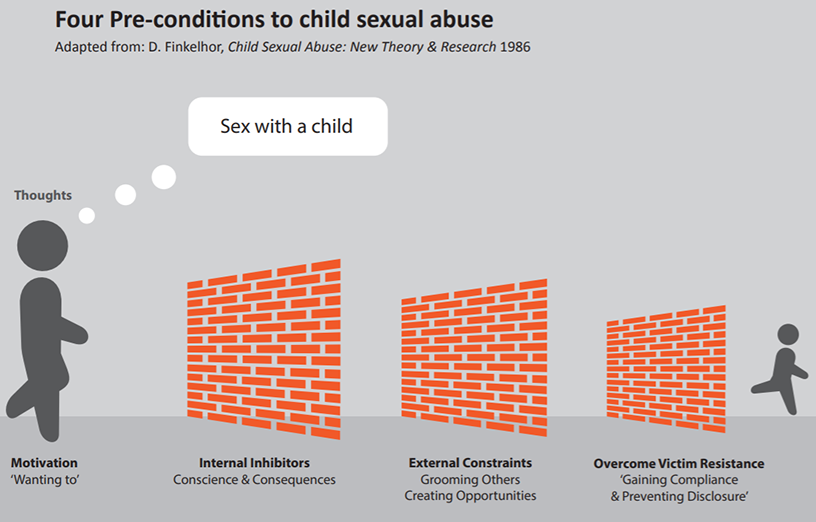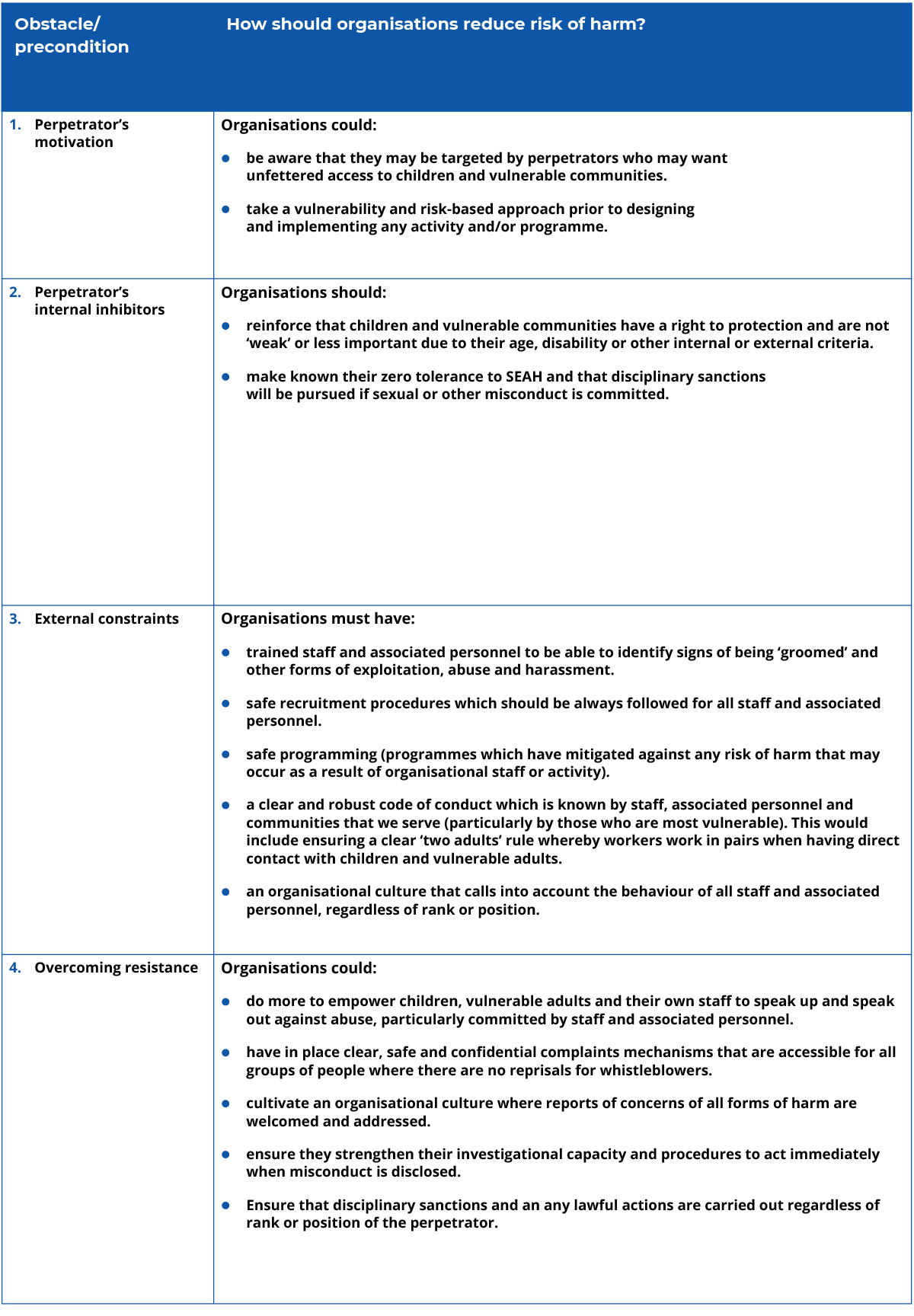Unit 3: Prevention
3.3 Safe recruitment
Safe recruitment policies and practice is a key preventative step.
Profile of sexual offenders

(©Source: Lucy Faithfull Foundation: Four pre-conditions to child sex abuse)
One of the biggest areas of risk for organisations who work with children and/or vulnerable adults is that posed by those who seek to sexually abuse children and vulnerable adults. Knowing more about perpetrators of sexual abuse, and their thought processes and actions, will help us strengthen our preventative measures.
One of the most significant contributions to understanding the behaviour of sexual offenders was proposed by Dr. David Finkelhor (1984) and is known as the Four Preconditions Model. This model argues that there are four preconditions, which could be seen as ‘hurdles’ or ‘obstacles’, that the sexual offender must overcome.
While the theory originally applied to those committing sexual offences against children, the same principles apply to the sexual exploitation and abuse of adults too.
Obstacle 1 (Motivation)
This is the first precondition, where sexual perpetrators already have an intention to commit sexual abuse and exploitation.
Obstacle 2 (Overcoming internal inhibitors)
Sexual abusers know that their intended actions are wrong, and so any feelings of moral conscience must somehow be overcome as well as the fear of being caught. They often find excuses to justify their actions and what motivates them to commit abuse.
Obstacle 3 (Overcoming external inhibitors)
This obstacle is when perpetrators try to access children or vulnerable adults, whether or not there are external obstacles in the way, such as robustly implemented organisational policies and procedures. Perpetrators will try and obtain jobs or volunteering opportunities that provide them access to direct or indirect contact, and they will manipulate carers/parents and staff in these organisations to obtain greater access.
Obstacle 4 (Overcoming resistance)
This is the final hurdle, where perpetrators have obtained positions of trust and gained access to their victims. At this point they would have overcome the resistance of victims as well as the adults who care for them. This is achieved through a whole range of strategies from ‘sexually grooming’ the individual, through either force, coercion, manipulation, lying or trickery, by giving gifts or making threats to prevent survivors from disclosing. If no action is taken against the perpetrator, they will re-offend and repeatedly perpetrate their abuse.
This model is useful, not only to provide an insight into the behaviour of those seeking to abuse, but also to use as a tool to enable us to identify gaps in our safeguarding measures.
|
Activity 3.7 How should organisations reduce the risk of harm? Now that you have learnt a bit more about the profile of sexual perpetrators, use the table below to identify in what you think organisations could do or should do to prevent perpetrators from overcoming the four obstacles mentioned Here is a writable version of this risk of harm template shown below. You can type into this PDF form and then save it and/or print it.
|
If you want to learn more about the Finkelhor model and how to take preventative steps, follow the links below.
- The Finkelhor model
- Steps towards prevention Lucy Faithfull Foundation
Importance of safe recruitment

In Course 1: Introduction to Safeguarding in the International Aid Sector we covered the need for organisations to ensure that they adopted safe selection and recruitment policies and practices when recruiting staff, volunteers, consultants and other associated personnel.
Part of this is to gauge candidates’ motivations for working with organisations who have access to children and vulnerable adults. Having safe and robust recruitment practices is a mitigating measure against the risk of facilitating those entering into our organisations wishing to harm children or vulnerable adults.
It is important to understand and remember that people who sexually abuse children or adults with disabilities do not usually stand out from the crowd. On the contrary, they can often be charming, friendly and helpful, and can successfully get themselves employed in education, health and care settings. They have the ability to gain the trust of children and adults with what is recognised as ‘sexual grooming’ behaviour. Before getting access to children or vulnerable adults, abusers may first have to groom the management and/or carers of an organisation.
Safe recruitment checklist
Safer recruitment practices are important, but even the best recruitment practices will not prevent those who want to abuse children and vulnerable adults being recruited by aid agencies, either in paid or unpaid capacities. That is why safe working practices and codes of conduct are also essential.
You will already be aware of the importance of safe recruitment and good practice. For example, through:
- Stating clearly in job applications that your organisation has a safeguarding policy and zero tolerance against all forms of harm, particularly sexual abuse, exploitation and sexual harassment.
- Ensuring that the interview panel (or at least one of its members) is trained in safeguarding.
- Exploring candidates’ motivations for working with children.
- Asking candidates questions specifically about safeguarding and why it is important to their roles (even when they may not have direct contact with children).
- Ensuring candidates sign a statement of commitment to your safeguarding policy and your code of conduct as a condition of employment.
- Obtaining, at a minimum, two references from previous organisations and ensuring they are verified with the previous employers by interview.
- Undertaking a check with the Misconduct Disclosure Scheme as to whether the candidate used to work with an organisation registered with the scheme.
- Undertaking a criminal record check such as the Disclosure Barring Scheme in the UK, completing a Criminal records checks for overseas applicants wanting to work for UK agencies, using the ACRO criminal records information service, obtaining a Letter or Certificate of Good Conduct (e.g. in Kenya, Uganda and many other countries) or equivalent police check.
|
Activity 3.8 Strengthening prevention for children and adults with disabilities How might you expand these preventative practices further to strengthen prevention for children and adults with disabilities? You may need to discuss this with other staff in your organisation responsible for recruiting. Record your answers in your learning journal. |
If you want to learn more about what organisations can do to improve their safeguarding guidelines, follow the link below.
The Disability-inclusive Child Safeguarding Guidelines 2021
Silent survivors – a case study

Read the following case study and then consider the questions posed at the end.
Ajij is a 25-year-old Indonesian national who volunteers in a child-friendly space (CFS) in Sulawesi, Indonesia. He lost much of his family – including a younger brother, nieces and nephews – in the 2018 tsunami. At the CFS he has become particularly close with Kadek, a deaf six-year-old, whose parents have died. With his family, Kadek had used a local sign language dialect, but nobody at the CFS knows the language. Ajij has learnt a few basic signs, but most of his communication with Kadek happens through football and art. Kadek is energetic and enthusiastic. After he scores, he waves his hands in the air and opens his mouth as if cheering. His artwork is full of playful animals, vibrant colours and bold brush strokes.
A couple of months ago, the INGO sent a new worker, Danelle, to oversee the CFS because she had a background in early childhood development and special education. Shortly after she arrived, Ajij noticed that Kadek seemed more contained than usual. He still played football with Ajij and seemed happy to see him, but his cheering was more subdued. His artwork began featuring darker colours and carefully drawn boxes. At first Ajij was concerned that Kadek was suffering from an illness. Then he began noticing a pattern. On the days when Danelle was not in the CFS, Kadek would seem more like his old self; when she was around, he was more reserved. Ajij felt confused. When he tried to get Kadek to tell him what was wrong, all the child would do is sign, “don’t like”. From his training, Ajij knew he could report a suspicion. But to whom should he report? He couldn’t go to the manager because his concerns were about her. After deliberating, he decided to raise his concerns to his organisation’s Safeguarding Focal Point (SFP).
The SFP was visibly uncomfortable about Ajij’s report, but she assured him she would inform the safeguarding committee, which then authorised an internal investigation. The SFP contacted Kadek’s aunt who was caring for him. They brought in a sign language translator to translate for Kadek. Then they interviewed other staff members and Danelle was last. The investigation determined that Danelle would shout at Kadek and pinch him in his private parts when he would not do as she was telling him to. The investigation also found out that Danelle had been warned about her behaviour towards children before. Disciplinary action was taken against Danelle according to the local Human Resources manual.
(© Adapted from Bond’s Complaint-Handling case studies)
|
Activity 3.9 Silent survivors – a case study Reflect on and respond to the following questions in your learning journal:
|


